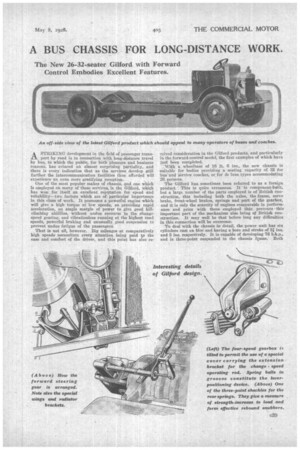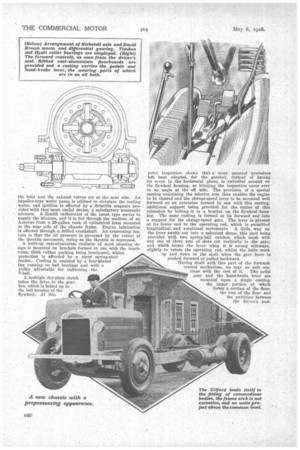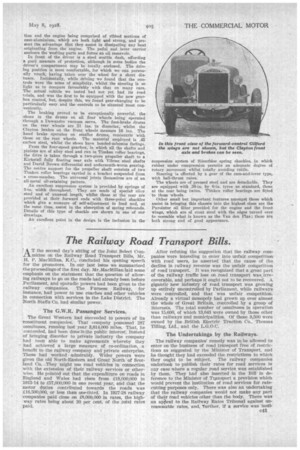A BUS CHASSIS FOR LONG-DISTANCE WORK.
Page 67

Page 68

Page 69

If you've noticed an error in this article please click here to report it so we can fix it.
The New 26-32-seater Gilford with Forward Control Embodies Excellent Features.
AA STRIKING development in the field of passenger transport by road is in connection with long-distance ,travel by bus, to which the public, for both pleasure and business reasons, has evinced aii almost surprising partiality, and there is every indication that as the services develop still further the intercommunication facilities thus' afforded will experience an even more gratifying reception. One of the Most popular makes of chassis, and one which Is employed on many of these services, is the .Gilford, which has won for itself an excellent reputation for speed and reliability—two factors which are of particular importance in this class of work. It possesses a powerful engine wbielt will give a high torque at low speeds; so providing rapid acceleration, an ample margin of power to give good hillclimbing abilities, without undue recourse to the change speed gearing, and vibrationless running at the highest road speeds, powerful braking and unusually good suspension to prevent undue fatigue of the passengers.
That is not all, however. Big mileages at comparatively high speeds necessitate every attention being paid to the ease and comfort of the driver, and this point has also re
ceived consideration in the Gifford products, and particularly in the forward-control model, the first examples of which have just been eonapleted.
With a wheelbase of 16 ft. 6 ins., the new chassis is suitable for bodies providing a seating capacity of 32 for bus mid 'service coaches, or for de luxe types accommodating 26 persons.
The Gilford has, sometimes been referred to as a foreign product. This is quite erroneous. It is component-built, but a large number of the parts employed is of British construction, this including both the axles, the frame, servo brake, front-wheel brakes, springs and part of the gearbox, and it is only the scarcity of engines comparable in performance and price with those employed that prevents • this important part of the mechanism also being of British construction. It may well be that before long any difficulties in this connection will be overcome.
To deal with the chassis in detail, the power unit has six cylinders cast en bloc and having a bore and stroke of n ins. and 5 ins. respectively. It is capable of developing 76 b.h.p., and is three-point suspended in the chassis frame. Both the inlet and the exhaust valves are at the near side. An impeller-type water pump is utilized to circulate the cooling -water, and ignition is effected by a Scintilla magneto provided with that most useful device, a satisfactory automatic advance. A Zenith carburetter of the latest type serves to supply the mixture and it is fed through the medium of an Autovac from a 24-gallon tank of cylindrical form mounted at the near side of the chassis frame. Engine lubrication is effected through a drilled crankshaft. An interesting feature is that the oil pressure is governed by the extent of the throttle movement, rising as the throttle is depressed.
A built-up cast-aluminium radiator of most pleasing design is mounted on brackets formed in one with the dumbirons, thick rubber packing being inteiposed, whilst protection is afforded by a stout spring-steel fender. Cooling is assisted by a four-bladed fan running on ball bearings and with a pulley adjustable for tightening the V-belt.
A multiple dry-plate clutch takes the drive to the gearbox, which is bolted up to the bell housing of the flywheel. At this point inspection shows that a most unusual procedure ha's• been adopted, for the gearbox, instead of having its cover in the horizontal plane, is swivelled around on the flywheel housing, so bringing the inspection cover over to an angle at the off side. The provision of a special casting containing the selector arm thus enables the engine to be cleared and the change-speed lever to be mounted well forivard on an extension formed in one with this casting, additional support being provided for the centre of this extension by bolting it to a bracket on the flywheel housing. The same casting is formed at its forward end into a support for the change-speed gate. The lever is pivoted at its lower end to the operating rod, which is permitted longitudinal and rotational movements. A little way up the lever swells out into a spherical shape, this part being provided with two spring-ball catches, which mesh with any one of three sets of slots cut vertically in the gate, and which locate the lever when it is swung sideways, slightly to rotate the operating rod, whilst the balls work tip and down in the slots when the gear lever is pushed forward or pulled backward.
Having dealt with this part of the forwardcontrol mechanism, we may as well continue with the rest of it. The pedal gear and the hand-brake lever are mounted upon a single casting, the upper portion of which forms a section of the floor, the rest of the floor and the partition between the driver's posi lion and the engine being comprised of ribbed sections of cast-aluminium, which are both light asnd strong, and present the advantage that they assist in dissipating any heat originating from the engine. The pedal and lever carrier encloses the weal:bag parts and forms an oil reservoir.
In front of the driver is a steel scuttle dash, affording a good measure of protection, although in some bodies the driver's compartment may be totally enclosed. The driving position is most comfortable, for which we can personally vouch, having taken over the wheel for a short distance. Incidentally, while driving we found that the controls were the acme of simplicity, whilst the steering is so light as to compare favourably with that on many cars. The actual vehicle we tested had not yet had its road trials, and was the first to be equipped with the new gearbox control, but, despite this, we found gear-changing to be particularly easy and the controls to be situated most conveniently.
The braking proved to be exceptionally powerful, the shoes in the drums on all four wheels being operated through a Dewandre vacuum servo. The foot-brake drums on the rear wheels are 21 ins, in diameter, whilst the Clayton brakes on the front wheels measure 16 ins. The hand brake operates on smaller drums, concentric with those on the rear wheels. The material employed is .45 carbon steel, whilst the shoes have bonded-asbestos facings.
From the four-speed gearbox, in which all the shafts and pinions are of alloy steel and run in Timken roller bearings, the drive is taken through a two-piece propeller shaft to a Kirkstall fully floating rear axle with Vibrac steel shafts and David Brown differential and underneath-worm gearing. The centre support for the propeller shaft consists of two Timken roller bearings carried in a bracket suspended from a cross-member. The universal joints themselves are of an all-metal oil-retaining pattern.
An excellent suspension system is provided by springs of 3-in, width throughout. They are made of seeciat tinny steel and of unusual length, whilst those at the rear are provided at their forward ends with three-point shackles which give a measure of self-adjustment to load and, at the -same time, assist in the absorption of spring rebounds. Details of this type of shackle are shown in one of our drawings.
An excellent point in the design is the inclusion in the suspension system of Silentbloc spring shackles, in which rubber under compression permits an adequate degree of rotary movement whilst totally avoiding rattle. Steering is effected by a gear of the cam-and-lever type, with ball-thrust races.
The wheels are of pressed steel and are detachable. They are equipped with 36-in. by 6-in. tyres as standard, those at the rear being twins. Timken roller bearings are fitted to these wheels.
Other small but important features amongst those which assist in bringing this chassis into the highest class are the Purolator oil filter provided for the engine and the front wings, which are of stout steel with the edges turned over to resemble what is known as the Van den Phis; these are both strong and of good appearance.
























































































































